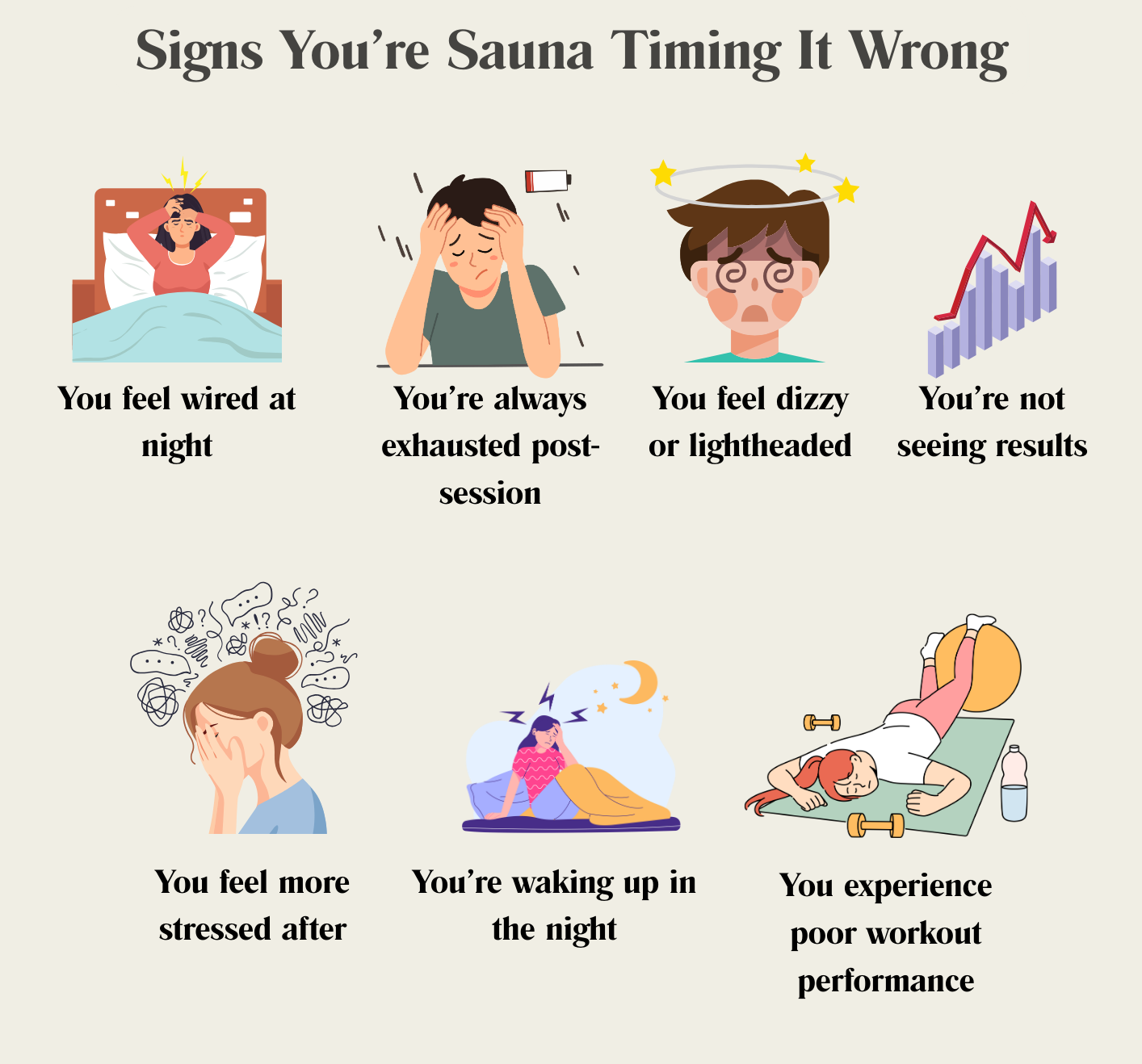Best Time For Sauna For Weight Loss & Workout Recovery

Ever had that "why am I even bothering?" moment after weeks of sauna sessions with nothing to show for it? Turns out, using a sauna “whenever you feel like it” might not be giving you the best results. There is real science behind timing things right, and the best time for sauna use can actually help you burn more fat, recover faster, and feel better overall.
In this guide, we are talking about syncing your sauna time with your body’s natural rhythm so you are not just sweating, you are making it count.
A Handy Cheat Sheet On The Best Time For Sauna
|
Goal |
Best Time |
Duration |
Frequency |
Notes |
|
Weight Loss |
Morning (fasted state) |
15-20 minutes |
3-4x weekly |
Hydrate well; may increase metabolism for hours after |
|
Workout Recovery |
30-60 min post-workout |
15-30 minutes |
After intense training days |
Enhances blood flow to muscles and reduces inflammation |
|
Sleep Enhancement |
Evening (1-2 hours before bed) |
15-20 minutes |
3-5x weekly |
Helps lower core body temperature for better sleep |
|
Performance Boost |
Morning or 1-2 days before competition |
15-20 minutes |
Regular conditioning needed |
Increases heat shock proteins and plasma volume |
|
Stress Reduction |
After work/evening |
20-30 minutes |
As needed/3-5x weekly |
Triggers parasympathetic nervous system activation |
How Sauna Helps With Weight Loss & Recovery: The Science Behind It Explained
Here’s a quick look at how sauna sessions support weight loss and muscle recovery:
Sauna Heat-Induced Metabolic Response

Sauna sessions create a controlled form of heat stress that triggers several metabolic adaptations beneficial for weight management. Research shows that heat exposure increases heart rate similar to moderate-intensity exercise, potentially burning 400-600 calories during a 30-minute infrared sauna session.
In addition to burning calories, heat exposure may also improve insulin sensitivity, which means your body can use blood sugar more effectively for energy instead of storing it as fat. It can also support fat oxidation, a process where your body breaks down fat and uses it as fuel.
Plus, it may increase growth hormone levels, which help build muscle, burn fat, and repair tissues. Together, these effects can make it easier to lose weight and improve your body composition.
Sauna Muscle Recovery Acceleration

For workout recovery, saunas work through multiple mechanisms:
- Increased blood flow delivers nutrients to damaged tissues
- Heat shock proteins help repair damaged muscle fibers
- Reduced inflammation speeds up the recovery process
- Improved insulin sensitivity enhances nutrient delivery
A study concluded that post-exercise sauna bathing reduced delayed onset muscle soreness (DOMS) and accelerated strength recovery compared to passive recovery techniques.
Best Time For Sauna To Get Maximum Weight Loss Results

Here is the optimal sauna schedule to support weight loss:
Morning Sessions In Fasted State
Using a sauna in the morning, particularly in a fasted state, offers many advantages for weight loss:
- It increases norepinephrine, a hormone that can help activate brown fat, which burns calories to create heat.
- Your body may burn more fat when it’s low on stored carbs (like in the morning before breakfast).
- It gives your metabolism a boost that can last for hours.
- It might also help control your appetite throughout the day.
Research suggests morning sauna sessions between 6-9 AM to amplify these effects. One study found that regular morning sauna users had lower BMI and waist circumference measurements compared to evening users with similar lifestyle habits.
Evening Sessions For Metabolic Advantages
Evening sauna sessions from 6-9 PM offer different but equally valuable benefits:
- Increase insulin sensitivity before dinner to help your body use carbohydrates for energy instead of storing them as fat.
- Lower cortisol levels that reduce stress-related fat storage, especially around the belly.
- Improves your sleep quality to support weight management by balancing hunger hormones like ghrelin and leptin.
- Enhances overnight muscle recovery that promotes muscle repair and growth hormone release while you sleep.
The ideal timing may ultimately depend on your daily schedule and when you can consistently incorporate sauna sessions. Consistency matters more than perfect timing for long-term results.
Best Time To Use A Sauna After Workout For Better Muscle Recovery

Here’s when sauna sessions work best for muscle repair:
Post-Workout Timing Strategy
Research suggests the sweet spot for using a sauna after a workout is 30 minutes to 2 hours later. The timing matters because your body is already in a recovery mode, and the sauna can speed that up.
Why this timing works best:
- Your body is already warm, so the sauna doesn’t need to raise your temperature from scratch, which keeps recovery momentum going.
- Blood is flowing more efficiently to your muscles, helping deliver oxygen and nutrients exactly where they’re needed for repair.
- Inflammation peaks during this window, and heat exposure may help modulate that response to reduce soreness and promote healing.
- Your muscles are replenishing glycogen, and improved circulation from the sauna may help shuttle glucose into cells faster for energy storage and recovery.
Pre-Workout Considerations
While less common, pre-workout sauna sessions (3-4 hours before training) can offer unique benefits:
- Boosts heat shock proteins - Helps protect your muscles during the workout and improves recovery later.
- Loosens tight muscles and joints - Makes your body feel more mobile and reduces the risk of strains or stiffness.
- Wakes up your nervous system - Helps your brain and body connect better for sharper movement and faster reaction times.
Note: Pre-workout sauna use requires careful hydration strategies and should be avoided immediately before intense training, as it may compromise performance through premature fatigue.
Recovery Day Protocol
On rest days, stepping into the sauna between 1 PM and 4 PM can help your body and mind bounce back better. These sessions can:
- Boost blood flow, which helps deliver nutrients and oxygen to tired muscles so they can heal faster.
- Align your natural cortisol dip to help your body relax more deeply during the afternoon when stress hormones are lower.
- Refresh your mind, offering a calm, restorative break that helps you feel more focused and recharged for the next training day.
User-Specific Sauna Timing Recommendations: Find Your Ideal Duration

Sauna timing isn’t one-size-fits-all—here’s how different people can optimize their sessions for fat loss and recovery:
1. Beginners vs. Experienced Athletes
- Beginners: Start with 5-10 minute sessions in the morning (7-9 AM) for metabolic boost or 30-45 minutes post-workout for recovery. Limit to 2-3 weekly sessions initially.
- Experienced athletes: Optimize with 15-20 minute fasted morning sessions (6-8 AM) for fat mobilization or 20-30 minute sessions 45-60 minutes post-workout for enhanced recovery. Can increase to 4-5 weekly sessions for maximum benefits.
2. People with Cardiovascular Or Respiratory Conditions
- Cardiovascular concerns: Choose mid-morning (9-11 AM) for gentler metabolic enhancement when blood pressure is naturally stable.
- Respiratory conditions: Time sessions for early afternoon (1-3 PM) when airways tend to be most open to maximize oxygen utilization during fat-burning sessions.
- Both groups: Start with shorter 5-8 minute durations, gradually building to 10-15 minutes maximum with 24-48 hours between sessions.
3. Women’s Considerations (Menstrual Cycle, Hormonal Fluctuations)
- Follicular phase (Days 1-14): Schedule morning sessions (7-9 AM) for optimal fat burning when metabolism is naturally higher.
- Luteal phase (Days 15-28): Schedule evening sessions (4-6 PM) when body temperature is already elevated for enhanced calorie expenditure.
- Recovery timing: Post-workout sauna sessions may need 10-15 minutes longer during high-hormone phases for the same recovery benefit.
4. Older Adults & Heat Tolerance
- Morning sessions: Ideal between 9-11 AM when coordination and alertness peak, allowing safer movement in and out of the sauna.
- Duration: Begin with 8-10 minute sessions, building to 15 minutes maximum.
- Recovery window: Allow 60-90 minutes post-workout (versus 30-60 for younger adults) before sauna session for initial cooling.
- Frequency: Limit to every other day to allow complete recovery between heat exposures.
7 Signs You Are Using The Sauna At The Wrong Time

Watch for these signs that your sauna timing might be off:
- You feel wired at night – Using the sauna too late can spike your core temperature and disrupt sleep.
- You’re always exhausted post-session – Sauna timing too close to intense workouts may overtax your recovery.
- You feel dizzy or lightheaded – Could signal dehydration or sauna use on an empty stomach at the wrong time.
- You’re not seeing results – If fat loss or recovery stalls, your sauna timing may not match your goal.
- You feel more stressed after – Midday sauna use during peak cortisol hours might interfere with relaxation.
- You’re waking up in the night – Late evening sessions without a cooldown may delay melatonin production.
- You experience poor workout performance – A pre-workout sauna too close to training can cause early fatigue.
Practical Sauna Timing Tips To Get The Most Out of Every Session

Maximize your sauna benefits with these simple and effective timing tips:
Hydration Timing
- Drink 16-20 oz of water 60-90 minutes pre-sauna
- Bring water to sip during longer sessions
- Consume 16-24 oz immediately after
- Consider electrolyte replacement for sessions exceeding 20 minutes
Meal Timing Considerations
- Avoid heavy meals 1-2 hours before sauna use
- Fasted morning sessions may enhance fat mobilization
- Post-sauna represents an excellent window for protein intake after workouts
- Carbohydrate replacement becomes more important after combined workout/sauna stress
Sleep Considerations
- Complete sauna sessions at least 60 minutes before bedtime
- Follow with a cold shower to trigger a temperature drop
- Consider complementary relaxation techniques post-sauna
- Maintain consistent timing for circadian rhythm entrainment
Conclusion
The best time for sauna sessions depends largely on your primary goal. For weight loss benefits, morning fasted sessions offer metabolic advantages. For workout recovery, the 30-60 minute window after training reduces soreness and accelerates strength recovery. However, the most effective sauna timing strategy is ultimately one you can maintain consistently.
Ready to build your own recovery ritual? Nordvik offers premium at-home saunas designed for modern lifestyles. If you're chasing peak performance, better sleep, or just a little daily peace, our wide range of barrel saunas, panorama saunas, and cube saunas brings professional-grade wellness right into your home.
FAQs
Can I sauna every day?
Yes, daily sauna use is generally safe for healthy individuals and may offer cumulative benefits like stress relief, improved circulation, and detoxification. Just stay hydrated and listen to your body for signs of overheating or fatigue.
Should I shower after a sauna?
Yes, it’s a good idea to shower after a sauna to rinse off sweat and toxins released through your pores. Use cool or lukewarm water to help lower your body temperature gradually and close the pores.
What do 15 minutes in the sauna do?
A 15-minute sauna session can raise your core temperature, boost circulation, relax muscles, and trigger light sweating. This short session may also support cardiovascular conditioning and reduce stress hormones, leaving you feeling refreshed and calm.
How long should I sit in a sauna?
Most people benefit from 15 to 30 minutes per session, depending on the heat and their tolerance. Start with shorter durations if you're new, and always exit if you feel dizzy or uncomfortable.

